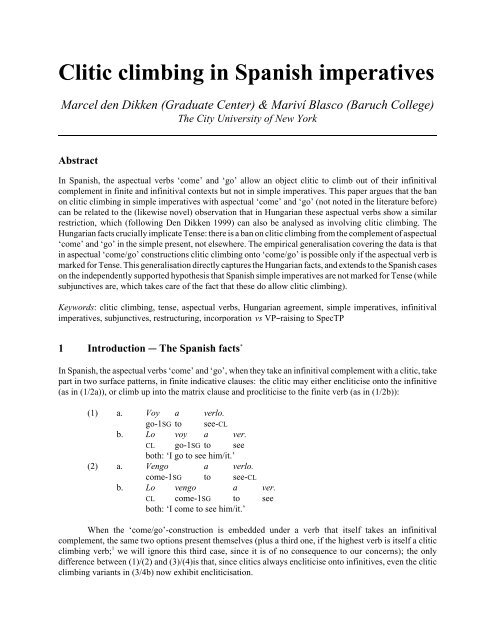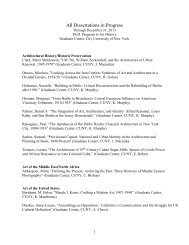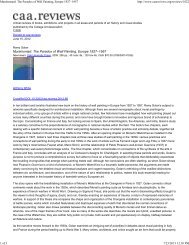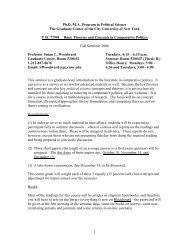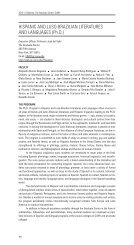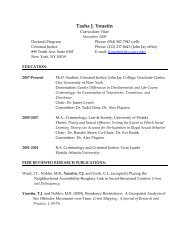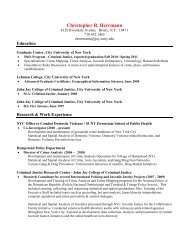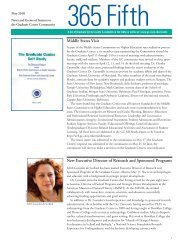Clitic climbing in Spanish imperatives - CUNY Graduate Center
Clitic climbing in Spanish imperatives - CUNY Graduate Center
Clitic climbing in Spanish imperatives - CUNY Graduate Center
Create successful ePaper yourself
Turn your PDF publications into a flip-book with our unique Google optimized e-Paper software.
<strong>Clitic</strong> <strong>climb<strong>in</strong>g</strong> <strong>in</strong> <strong>Spanish</strong> <strong>imperatives</strong><br />
Marcel den Dikken (<strong>Graduate</strong> <strong>Center</strong>) & Mariví Blasco (Baruch College)<br />
The City University of New York<br />
Abstract<br />
In <strong>Spanish</strong>, the aspectual verbs ‘come’ and ‘go’ allow an object clitic to climb out of their <strong>in</strong>f<strong>in</strong>itival<br />
complement <strong>in</strong> f<strong>in</strong>ite and <strong>in</strong>f<strong>in</strong>itival contexts but not <strong>in</strong> simple <strong>imperatives</strong>. This paper argues that the ban<br />
on clitic <strong>climb<strong>in</strong>g</strong> <strong>in</strong> simple <strong>imperatives</strong> with aspectual ‘come’ and ‘go’ (not noted <strong>in</strong> the literature before)<br />
can be related to the (likewise novel) observation that <strong>in</strong> Hungarian these aspectual verbs show a similar<br />
restriction, which (follow<strong>in</strong>g Den Dikken 1999) can also be analysed as <strong>in</strong>volv<strong>in</strong>g clitic <strong>climb<strong>in</strong>g</strong>. The<br />
Hungarian facts crucially implicate Tense: there is a ban on clitic <strong>climb<strong>in</strong>g</strong> from the complement of aspectual<br />
‘come’ and ‘go’ <strong>in</strong> the simple present, not elsewhere. The empirical generalisation cover<strong>in</strong>g the data is that<br />
<strong>in</strong> aspectual ‘come/go’ constructions clitic <strong>climb<strong>in</strong>g</strong> onto ‘come/go’ is possible only if the aspectual verb is<br />
marked for Tense. This generalisation directly captures the Hungarian facts, and extends to the <strong>Spanish</strong> cases<br />
on the <strong>in</strong>dependently supported hypothesis that <strong>Spanish</strong> simple <strong>imperatives</strong> are not marked for Tense (while<br />
subjunctives are, which takes care of the fact that these do allow clitic <strong>climb<strong>in</strong>g</strong>).<br />
Keywords: clitic <strong>climb<strong>in</strong>g</strong>, tense, aspectual verbs, Hungarian agreement, simple <strong>imperatives</strong>, <strong>in</strong>f<strong>in</strong>itival<br />
<strong>imperatives</strong>, subjunctives, restructur<strong>in</strong>g, <strong>in</strong>corporation vs VP%rais<strong>in</strong>g to SpecTP<br />
1 Introduction & The <strong>Spanish</strong> facts *<br />
In <strong>Spanish</strong>, the aspectual verbs ‘come’ and ‘go’, when they take an <strong>in</strong>f<strong>in</strong>itival complement with a clitic, take<br />
part <strong>in</strong> two surface patterns, <strong>in</strong> f<strong>in</strong>ite <strong>in</strong>dicative clauses: the clitic may either encliticise onto the <strong>in</strong>f<strong>in</strong>itive<br />
(as <strong>in</strong> (1/2a)), or climb up <strong>in</strong>to the matrix clause and procliticise to the f<strong>in</strong>ite verb (as <strong>in</strong> (1/2b)):<br />
(1) a. Voy a verlo.<br />
go-1SG to see-CL<br />
b. Lo voy a ver.<br />
CL go-1SG to see<br />
both: ‘I go to see him/it.’<br />
(2) a. Vengo a verlo.<br />
come-1SG to see-CL<br />
b. Lo vengo a ver.<br />
CL come-1SG to see<br />
both: ‘I come to see him/it.’<br />
When the ‘come/go’-construction is embedded under a verb that itself takes an <strong>in</strong>f<strong>in</strong>itival<br />
complement, the same two options present themselves (plus a third one, if the highest verb is itself a clitic<br />
<strong>climb<strong>in</strong>g</strong> verb; 1 we will ignore this third case, s<strong>in</strong>ce it is of no consequence to our concerns); the only<br />
difference between (1)/(2) and (3)/(4)is that, s<strong>in</strong>ce clitics always encliticise onto <strong>in</strong>f<strong>in</strong>itives, even the clitic<br />
<strong>climb<strong>in</strong>g</strong> variants <strong>in</strong> (3/4b) now exhibit encliticisation.
Marcel den Dikken & Mariví Blasco & <strong>Clitic</strong> <strong>climb<strong>in</strong>g</strong> <strong>in</strong> <strong>Spanish</strong> <strong>imperatives</strong><br />
(3) a. Puedo ir a verlo.<br />
I-can go to see-CL<br />
b. Puedo irlo a ver.<br />
I-can go-CL to see<br />
both: ‘I can go to see him/it.’<br />
(4) a. Puedo venir a verlo.<br />
I-can come to see-CL<br />
b. Puedo venirlo a ver.<br />
I-can come-CL to see<br />
both: ‘I can come to see him/it.’<br />
Inf<strong>in</strong>itival constructions are not the only context <strong>in</strong> Romance <strong>in</strong> which we f<strong>in</strong>d enclisis: positive<br />
<strong>imperatives</strong> also exhibit this. On the basis of the patterns established <strong>in</strong> (1)%(4), we are now led to expect that<br />
<strong>in</strong> positive <strong>imperatives</strong> with the aspectual verbs ‘come/go’, two surface word-order patterns should manifest<br />
themselves, basically parallel to the ones seen <strong>in</strong> (3)/(4): the clitic should be able to encliticise either onto<br />
the <strong>in</strong>f<strong>in</strong>itive embedded under ‘come/go’, or onto the imperative verb ‘come/go’ itself. Interest<strong>in</strong>gly,<br />
however, this expectation is not borne out:<br />
(5) a. Ve a verlo!<br />
go to see-CL<br />
‘Go to see him/it!’<br />
b. *Velo a ver!<br />
go-CL to see<br />
(6) a. Ven a verlo!<br />
come to see-CL<br />
b.<br />
‘Come to see him/it!’<br />
(?)? Venlo a ver!<br />
come-CL to see<br />
Of the examples <strong>in</strong> (5), (5b) is flatly ungrammatical; and <strong>in</strong> the pair <strong>in</strong> (6), there likewise is a notable contrast<br />
between the example with clitic <strong>climb<strong>in</strong>g</strong> and the one without, the former be<strong>in</strong>g substantially degraded. 2<br />
The deviance of (5b) and (6b) & not noted <strong>in</strong> the literature before, to our knowledge & presents us<br />
with an <strong>in</strong>terest<strong>in</strong>g puzzle. The descriptive generalisation is not that clitic <strong>climb<strong>in</strong>g</strong> is <strong>in</strong>compatible with<br />
enclisis onto the higher verb & after all, (3/4b) are grammatical. Nor can we say that it is a property of<br />
<strong>imperatives</strong> that they block cliticisation & after all, simple <strong>imperatives</strong> with enclisis are perfectly wellformed.<br />
Instead, it seems to be a property specific to simple <strong>imperatives</strong> which makes clitic <strong>climb<strong>in</strong>g</strong><br />
impossible from the complement of the aspectual verbs ‘come’ and ‘go’.<br />
That we really have to make this statement as specific as this (mak<strong>in</strong>g reference to (i) simple<br />
<strong>imperatives</strong>, (ii) clitic <strong>climb<strong>in</strong>g</strong>, and (iii) aspectual ‘come/go’) is evident from the fact that with verbs like<br />
‘try’, and even with other aspectualisers such as ‘beg<strong>in</strong>’ and ‘f<strong>in</strong>ish’, clitic <strong>climb<strong>in</strong>g</strong> is not impossible <strong>in</strong><br />
<strong>Spanish</strong> <strong>imperatives</strong> & though (7b) and (8b) are generally deemed somewhat worse than the correspond<strong>in</strong>g<br />
non-<strong>climb<strong>in</strong>g</strong> cases <strong>in</strong> (7a) and (8a), they are not nearly as bad as the clitic <strong>climb<strong>in</strong>g</strong> cases <strong>in</strong> (5/6b). 3<br />
(7) a. {Intenta/ Aprende a} hacerlo!<br />
try learn to do-CL<br />
‘Try/Learn to do it!’<br />
2
Marcel den Dikken & Mariví Blasco & <strong>Clitic</strong> <strong>climb<strong>in</strong>g</strong> <strong>in</strong> <strong>Spanish</strong> <strong>imperatives</strong><br />
b.<br />
(?)<br />
{Inténtalo/ Apréndelo a} hacer!<br />
try-CL learn-CL to do<br />
(8) a. {Empieza a/ Term<strong>in</strong>a de} hacerlo!<br />
beg<strong>in</strong> to f<strong>in</strong>ish of do-CL<br />
b.<br />
‘Start/F<strong>in</strong>ish do<strong>in</strong>g it!’<br />
(?) {Empiézalo a/ Termínalo de} hacer!<br />
beg<strong>in</strong>-CL to f<strong>in</strong>ish-CL of do<br />
So the puzzle is how to account for the specific cocktail of properties that manifests itself <strong>in</strong> (5) and (6): the<br />
fact that clitic <strong>climb<strong>in</strong>g</strong> fails when the matrix verb is an imperative form of aspectual ‘come/go’.<br />
In this paper we set out to f<strong>in</strong>d a solution to this puzzle. We go about this job as follows. After reject<strong>in</strong>g<br />
(on the basis of English) a possible approach that would base itself on the premise that & for some<br />
reason & restructur<strong>in</strong>g is blocked categorically <strong>in</strong> <strong>imperatives</strong> with aspectual ‘come/go’ (section 2), we will<br />
present facts from Hungarian clitic <strong>climb<strong>in</strong>g</strong> with aspectual ‘come/go’ to make the case that clitic <strong>climb<strong>in</strong>g</strong><br />
with these verbs is dependent on a specification for Tense <strong>in</strong> the matrix clause (section 3). This generalisation<br />
will be seen (<strong>in</strong> section 4) to naturally carry over to the <strong>Spanish</strong> facts <strong>in</strong> (5/6b) on the assumption,<br />
<strong>in</strong>dependently defended for English <strong>imperatives</strong> <strong>in</strong> Beukema and Coopmans (1989), that simple <strong>imperatives</strong><br />
<strong>in</strong> <strong>Spanish</strong> lack a specification for Tense & a hypothesis for which <strong>in</strong>dependent support will be provided <strong>in</strong><br />
the text. It also makes sense of the difference between <strong>imperatives</strong> and subjunctives (polite <strong>imperatives</strong>) <strong>in</strong><br />
<strong>Spanish</strong>, when it comes to clitic <strong>climb<strong>in</strong>g</strong>. In section 5, we f<strong>in</strong>ally proceed to an analysis of the Tense effect,<br />
couched <strong>in</strong> a structural analysis of restructur<strong>in</strong>g <strong>in</strong> aspectual ‘come/go’ verbs <strong>in</strong> <strong>Spanish</strong> (and Hungarian)<br />
<strong>in</strong> terms of VP%movement to SpecTP.<br />
2 No general ban on restructur<strong>in</strong>g & The case of English ‘come/go’<br />
<strong>Clitic</strong> <strong>climb<strong>in</strong>g</strong> is often taken to be a hallmark of so-called ‘restructur<strong>in</strong>g’ (or ‘clause union’) effects (cf.<br />
Rizzi 1982 and much subsequent work). And s<strong>in</strong>ce clitic <strong>climb<strong>in</strong>g</strong> is possible <strong>in</strong> aspectual ‘come/go’<br />
constructions <strong>in</strong> <strong>Spanish</strong>, we can conclude that restructur<strong>in</strong>g is possible <strong>in</strong> them. This said, one may be<br />
tempted to blame the failure of clitic <strong>climb<strong>in</strong>g</strong> <strong>in</strong> the examples <strong>in</strong> (5/6b) on the failure of restructur<strong>in</strong>g.<br />
Notice, however, that clitic <strong>climb<strong>in</strong>g</strong> is possible <strong>in</strong> the <strong>imperatives</strong> <strong>in</strong> (7/8b). So there cannot be a<br />
general ban on restructur<strong>in</strong>g <strong>in</strong> <strong>imperatives</strong> & it apparently works successfully <strong>in</strong> <strong>imperatives</strong> with verbs like<br />
‘try’ and ‘beg<strong>in</strong>/f<strong>in</strong>ish’. Perhaps, then, restructur<strong>in</strong>g fails only <strong>in</strong> <strong>imperatives</strong> with aspectual ‘come/go’ type<br />
verbs? But that cannot be true as a general statement about the UG properties of aspectual verbs either, <strong>in</strong><br />
the light of the follow<strong>in</strong>g facts from English, discussed <strong>in</strong> detail by Jaeggli and Hyams (1993).<br />
In English, the aspectual verbs come and go are peculiar <strong>in</strong> that they can ‘shed’ the <strong>in</strong>f<strong>in</strong>itival marker<br />
to that occurs <strong>in</strong> their complement, under certa<strong>in</strong> circumstances. In particular, come and go can take a to-less<br />
‘bare’ <strong>in</strong>f<strong>in</strong>itival complement if they are themselves un<strong>in</strong>flected (i.e., show up as the bare stem), and not<br />
otherwise. The facts <strong>in</strong> (9) illustrate this for go; parallel facts obta<strong>in</strong> for come.<br />
(9) a. I/you/we/they go (to) fetch a newspaper every morn<strong>in</strong>g.<br />
b. (S)he goes *(to) fetch a newspaper.<br />
c. I/you/(s)he/we/they went *(to) fetch a newspaper.<br />
d. I/you/(s)he/we/they have/has gone *(to) fetch a newspaper.<br />
e. I/you/(s)he/we/they am/are/is go<strong>in</strong>g *(to) fetch a newspaper.<br />
f. I/you/(s)he/we/they want(s) to go (to) fetch a newspaper.<br />
g. go (to) fetch a newspaper!<br />
3
Marcel den Dikken & Mariví Blasco & <strong>Clitic</strong> <strong>climb<strong>in</strong>g</strong> <strong>in</strong> <strong>Spanish</strong> <strong>imperatives</strong><br />
Whenever the form of the aspectual verb is identical with the verb stem (i.e., <strong>in</strong> the simple present tense<br />
except for the third person s<strong>in</strong>gular, <strong>in</strong> <strong>in</strong>f<strong>in</strong>itives and <strong>in</strong> <strong>imperatives</strong>), to can rema<strong>in</strong> absent; otherwise it must<br />
show up. 4 One may relate the absence of to to the absence of overt <strong>in</strong>flectional morphology by say<strong>in</strong>g that,<br />
when to is absent, the lower ‘bare’ <strong>in</strong>f<strong>in</strong>itive and the aspectual verb undergo restructur<strong>in</strong>g & when to is<br />
absent, the only way to license the lower <strong>in</strong>f<strong>in</strong>itive is by <strong>in</strong>corporat<strong>in</strong>g it <strong>in</strong>to the aspectual verb; the l<strong>in</strong>k<br />
between to-drop and lack of <strong>in</strong>flectional morphology will then follow on the assumption that <strong>in</strong>flected verbs<br />
(<strong>in</strong> English at least) are not suitable <strong>in</strong>corporators/restructur<strong>in</strong>g predicates (possibly as a consequence of<br />
general restrictions on complex X 0 elements, perhaps of the type laid out <strong>in</strong> Kayne 1994).<br />
We will not dwell on the details of the restriction on restructur<strong>in</strong>g exhibited by the English come/go<br />
facts <strong>in</strong> (9). Instead, we will simply take them to be expla<strong>in</strong>ed by some morphophonological constra<strong>in</strong>t whose<br />
nature need not concern us here. What matters for our purposes is that restructur<strong>in</strong>g apparently succeeds <strong>in</strong><br />
the imperative <strong>in</strong> (9g): Go fetch a newspaper! is grammatical. What this shows is that even a relativisation<br />
of a putative ban on restructur<strong>in</strong>g <strong>in</strong> <strong>imperatives</strong> such that it would refer only to aspectual ‘come/go’ verbs<br />
would not be accurate cross-l<strong>in</strong>guistically: English would refute it. To make such a claim with specific<br />
reference to <strong>Spanish</strong> would hardly ga<strong>in</strong> us <strong>in</strong>sight <strong>in</strong>to what is really go<strong>in</strong>g on <strong>in</strong> (5)%(6), of course. At<br />
m<strong>in</strong>imum, we should try to relate the account of the <strong>Spanish</strong> facts to peculiarities of ‘come/go’ verbs<br />
elsewhere, and we should manage to prevent the analysis of the <strong>Spanish</strong> facts from <strong>in</strong>advertently carry<strong>in</strong>g<br />
over to English. In the next section, we will address the former task, turn<strong>in</strong>g to the latter towards the end of<br />
the paper.<br />
3 A Tense effect & The case of Hungarian clitic <strong>climb<strong>in</strong>g</strong> with ‘come/go’<br />
The <strong>Spanish</strong> facts which are at the heart of this paper (cf. (5)%(6)) present us with a prima facie surpris<strong>in</strong>g<br />
ban on clitic <strong>climb<strong>in</strong>g</strong> out of the complement of a class of verbs which is otherwise very flexible when it<br />
comes to clitic <strong>climb<strong>in</strong>g</strong>: the aspectual verbs ‘come’ and ‘go’. Interest<strong>in</strong>gly, <strong>in</strong> Hungarian these verbs also<br />
treat us to a tricky analytical problem, once aga<strong>in</strong> <strong>in</strong> the doma<strong>in</strong> of clitic <strong>climb<strong>in</strong>g</strong>. In this section we will<br />
lay out the relevant facts (first noted <strong>in</strong> Den Dikken 1999) and p<strong>in</strong>po<strong>in</strong>t the generalisation that covers them,<br />
subsequently tak<strong>in</strong>g this generalisation as the stepp<strong>in</strong>g-stone towards the analysis of the <strong>Spanish</strong> facts.<br />
Hungarian has two types of agreement: subject agreement (for the person and number of the subject)<br />
and object agreement (typically only for the def<strong>in</strong>iteness of the object). Subject and object agreement cannot<br />
be segmented; they surface as a portmanteau morpheme. This is illustrated <strong>in</strong> (10) (for <strong>in</strong>def<strong>in</strong>ite objects)<br />
and (11) (for def<strong>in</strong>ite objects).<br />
(10) a. János olvasott-i {i/valamit/egy könyvet/néhány könyvet/m<strong>in</strong>den könyvet}.<br />
János read-PAST-3SG.INDEF i/someth<strong>in</strong>g/a book/some book/every book<br />
b. *János olvast-a {i/valamit/egy könyvet/néhány könyvet/m<strong>in</strong>den könyvet}.<br />
János read-PAST-3SG.DEF i/someth<strong>in</strong>g/a book/some book/every book<br />
(11) a. *János olvasott-i {azt/a könyvet/azt a könyvet/Mari könyvét/Mar<strong>in</strong>ak a könyvét}.<br />
János read-PAST-3SG.INDEF that/the book/that the book/Mari book/Mari-DAT the book<br />
b. János olvast-a {azt/a könyvet/azt a könyvet/Mari könyvét/Mar<strong>in</strong>ak a könyvét}.<br />
János read-PAST-3SG.DEF that/the book/that the book/Mari book/Mari-DAT the book<br />
Every Hungarian object triggers either def<strong>in</strong>ite or <strong>in</strong>def<strong>in</strong>ite agreement on the f<strong>in</strong>ite verb. But there is one<br />
special deviation from the pattern. When the direct object is second person (s<strong>in</strong>gular or plural) and the<br />
subject is first person s<strong>in</strong>gular, a special agreement form shows up on the verb: the -lak/lek suffix, illustrated<br />
<strong>in</strong> (12):<br />
4
Marcel den Dikken & Mariví Blasco & <strong>Clitic</strong> <strong>climb<strong>in</strong>g</strong> <strong>in</strong> <strong>Spanish</strong> <strong>imperatives</strong><br />
(12) a. Én szeret-lek téged/titeket/benneteket.<br />
I love-LAK/LEK you sg/you pl-ACC/you pl-ACC<br />
b. *Én szeret-ek téged/titeket/benneteket.<br />
I love-INDEF you sg/you pl-ACC/you pl-ACC<br />
c. *En szeret-em téged/titeket/benneteket.<br />
I love-DEF you sg/you pl-ACC/you pl-ACC<br />
This -lak/lek form is arguably a complex entity (cf. also Simonyi 1907:352, Bartos 1997:364, fn. 2)<br />
& it consists of the -k of first person s<strong>in</strong>gular <strong>in</strong>def<strong>in</strong>ite agreement, a morphosyntactically un<strong>in</strong>terest<strong>in</strong>g epenthetic<br />
vowel, and the -l of second person. In effect, then, -lak/lek is the only Hungarian <strong>in</strong>flectional form <strong>in</strong><br />
which subject and object agreement appear to show up sequentially. Den Dikken (1999) makes a detailed<br />
case, however, for the claim that the -l of -lak/lek is not object agreement <strong>in</strong>flection but an object clitic. He<br />
shows that the clitic approach allows us to understand the otherwise elusive fact that there is <strong>in</strong>def<strong>in</strong>ite<br />
agreement (the -k of -lak/lek) <strong>in</strong> (12a), and provides <strong>in</strong>dependent support for the analysis from the realm of<br />
permissive causative constructions. 5 We will not go over the evidence here but simply adopt the analysis of<br />
-lak/lek <strong>in</strong> terms of cliticisation, treat<strong>in</strong>g -l as an object clitic <strong>in</strong> examples like (12a).<br />
Interest<strong>in</strong>gly, now, <strong>in</strong> Hungarian <strong>in</strong>dicative aspectual ‘come/go’ constructions with a first person<br />
s<strong>in</strong>gular subject and a second person object, the aspectual verb cannot show up with the complex marker -<br />
lak/lek (the comb<strong>in</strong>ation of an object clitic and subject <strong>in</strong>flection) <strong>in</strong> simple present-tense contexts: 6<br />
(13) a. Mentelek meglátogatni (téged).<br />
go-PAST-LAK/LEK PV-visit you<br />
‘I went to visit you.’<br />
b. *Megylek meglátogatni (téged).<br />
go(PRES)-LAK/LEK PV-visit you<br />
(14) a. Jöttelek meglátogatni (téged).<br />
come-PAST-LAK/LEK PV-visit you<br />
‘I came to visit you.’<br />
b. *Jölek meglátogatni (téged).<br />
come(PRES)-LAK/LEK PV-visit you<br />
The contrast is robust: while past-tense (13a) and (14a) are perfect, present-tense (13b) and (14b) are<br />
completely impossible. In the context of Hungarian -lak/lek agreement, this Tense effect manifests itself only<br />
with the aspectual ‘come/go’ type verbs (cf. note 6). With the -lak/lek form analysed <strong>in</strong> terms of object<br />
cliticisation (as <strong>in</strong> Den Dikken 1999), this suggests that there is someth<strong>in</strong>g peculiar to these verbs when it<br />
comes to clitic <strong>climb<strong>in</strong>g</strong>.<br />
In particular, the generalisation that suggests itself for the Hungarian facts is the follow<strong>in</strong>g:<br />
(15) <strong>Clitic</strong> <strong>climb<strong>in</strong>g</strong> onto aspectual ‘come/go’ is possible <strong>in</strong> Hungarian <strong>in</strong>dicatives only if the<br />
aspectual verb is marked for Tense.<br />
The Hungarian present tense is morphologically unmarked, while the past tense forms all feature a -t<br />
(doubled <strong>in</strong> certa<strong>in</strong> contexts; cf. jött ‘(s)he/it came’, jöttelek meglátogatni ‘I came to visit you’). Apparently,<br />
the presence of explicit mark<strong>in</strong>g for Tense is a precondition on successful clitic <strong>climb<strong>in</strong>g</strong> onto aspectual<br />
‘come/go’ <strong>in</strong> <strong>in</strong>dicative clauses (on subjunctives and conditionals, see note 11, below). With this<br />
generalisation <strong>in</strong> hand, let us return to the <strong>Spanish</strong> facts to see what sense we can make of those now.<br />
5
Marcel den Dikken & Mariví Blasco & <strong>Clitic</strong> <strong>climb<strong>in</strong>g</strong> <strong>in</strong> <strong>Spanish</strong> <strong>imperatives</strong><br />
4 Back to <strong>Spanish</strong> & True <strong>imperatives</strong> vs fake <strong>imperatives</strong> and the role of Tense<br />
Let us first refresh our memories. In <strong>Spanish</strong> simple <strong>imperatives</strong> with ‘come/go’ verbs featur<strong>in</strong>g an<br />
embedded <strong>in</strong>f<strong>in</strong>itive construed with an object clitic, the clitic can occur encliticised onto the <strong>in</strong>f<strong>in</strong>itive but<br />
it cannot encliticise onto the imperative ‘come/go’ verb:<br />
(5) a. Ve a verlo!<br />
go to see-CL<br />
‘Go to see him/it!’<br />
b. *Velo a ver!<br />
go-CL to see<br />
(6) a. Ven a verlo!<br />
come to see-CL<br />
b.<br />
‘Come to see him/it!’<br />
(?)? Venlo a ver!<br />
come-CL to see<br />
This turns out to be a restriction peculiar to simple <strong>imperatives</strong>, not to the entire illocutionary class of<br />
commands & thus, polite commands and negative <strong>imperatives</strong> do not exhibit it, as shown <strong>in</strong> (16) %(17): 7<br />
(16) a. Vaya a verlo!<br />
go-SUBJUNC to see-CL<br />
b.<br />
?<br />
Váyalo a ver!<br />
go-SUBJUNC-CL to see<br />
(17) a. No vaya(s) a verlo!<br />
not go-SUBJUNC to see-CL<br />
b. No lo vaya(s) a ver!<br />
not CL go-SUBJUNC to see<br />
Likewise, <strong>in</strong>f<strong>in</strong>itival <strong>imperatives</strong> are immune to the ban on clitic <strong>climb<strong>in</strong>g</strong> (cf. (18)), and so are what Bosque<br />
(1980) calls ‘retrospective <strong>imperatives</strong>’ of the type <strong>in</strong> (19), featur<strong>in</strong>g the auxiliary haber with a past<br />
participial complement headed by ido ‘gone’. 8<br />
(18) a. Ir a verlo!<br />
go-INF to see-CL<br />
b. Irlo a ver!<br />
go-INF-CL to see<br />
(19) a. Haber ido a verlo!<br />
have-INF gone to see-CL<br />
b. Haberlo ido a ver!<br />
have-INF-CL gone to see<br />
‘You should have gone to see him/it!’.<br />
Morphologically speak<strong>in</strong>g, the contrast between (5/6b) and (16/17b) <strong>in</strong>volves a difference between<br />
<strong>imperatives</strong> and subjunctives & <strong>Spanish</strong> uses the subjunctive to make polite and negative commands. This<br />
is <strong>in</strong>terest<strong>in</strong>g <strong>in</strong> the light of the generalisation that came out of the discussion of the Hungarian facts <strong>in</strong><br />
section 3. So we pick it up from there and build up an analysis of the <strong>Spanish</strong> facts from that po<strong>in</strong>t of view.<br />
6
Marcel den Dikken & Mariví Blasco & <strong>Clitic</strong> <strong>climb<strong>in</strong>g</strong> <strong>in</strong> <strong>Spanish</strong> <strong>imperatives</strong><br />
In section 3 we noted that Hungarian <strong>in</strong>dicative ‘come/go’ verbs allow clitic <strong>climb<strong>in</strong>g</strong> onto them only<br />
if they are marked for Tense. The dist<strong>in</strong>ction between <strong>imperatives</strong> and subjunctives <strong>in</strong> <strong>Spanish</strong> can be looked<br />
upon <strong>in</strong> the same light, on the assumptions <strong>in</strong> (20) (on (20a) see Beukema and Coopmans 1989). 9<br />
(20) a. <strong>Spanish</strong> simple <strong>imperatives</strong> are not marked for Tense.<br />
b. <strong>Spanish</strong> subjunctives are marked for Tense.<br />
The accuracy of the claims laid down <strong>in</strong> (20) for <strong>Spanish</strong> is shown by the impossibility of (21b), and by the<br />
grammaticality of the past-tense subjunctive <strong>in</strong> (22b) alongside the present-tense example <strong>in</strong> (22a).<br />
(21) a. Ve a verlo!<br />
go-IMP to see-CL<br />
b. *Ve+PAST a verlo!<br />
go-IMP-PAST to see-CL<br />
(22) a. Quiero que vayas a verlo.<br />
I-want that go-PRES.SUBJUNC.2SG to see-CL<br />
b. Quise que fueras a verlo.<br />
I-wanted that go-PAST.SUBJUNC.2SG to see-CL<br />
And we can support the absence of Tense from <strong>Spanish</strong> simple <strong>imperatives</strong> further on the basis of the ban<br />
on sentential negation <strong>in</strong> these constructions, illustrated <strong>in</strong> (23). 10<br />
(23) *No ve a verlo!<br />
not go to see-CL<br />
Given Zanutt<strong>in</strong>i’s (1997) arguments for an <strong>in</strong>extricable l<strong>in</strong>k between negation and Tense, the fact that<br />
<strong>Spanish</strong> simple <strong>imperatives</strong> cannot be negated is <strong>in</strong>controvertible evidence that they lack a projection of<br />
Tense.<br />
With the statements <strong>in</strong> (20) <strong>in</strong> hand, we may now return to the contrast between (5b) on the one hand,<br />
and (16b) and (17b) on the other, and relate it directly to the generalisation <strong>in</strong> (15) which emerged from our<br />
discussion of Hungarian: 11<br />
(24) <strong>Clitic</strong> <strong>climb<strong>in</strong>g</strong> onto aspectual ‘come/go’ is possible <strong>in</strong> <strong>Spanish</strong> commands only if the<br />
aspectual verb is marked for Tense.<br />
And with Tense tak<strong>in</strong>g centre-stage <strong>in</strong> the account of the restrictions on clitic <strong>climb<strong>in</strong>g</strong> <strong>in</strong> <strong>Spanish</strong> as well,<br />
we can readily understand why clitic <strong>climb<strong>in</strong>g</strong> is also successful <strong>in</strong> the ‘retrospective imperative’ <strong>in</strong> (19b):<br />
with Aspect (‘secondary Tense’) be<strong>in</strong>g dependent on a higher Tense, the perfect signals the presence of<br />
Tense <strong>in</strong> the matrix clause, and as a result clitic <strong>climb<strong>in</strong>g</strong> is unproblematic. 12<br />
So we may conclude this section on the positive note that, with (24) <strong>in</strong> place alongside (15), all the<br />
clitic <strong>climb<strong>in</strong>g</strong> restrictions discussed so far (from both <strong>Spanish</strong> and Hungarian) fall out from a simple<br />
statement about the role of Tense-mark<strong>in</strong>g.<br />
7
Marcel den Dikken & Mariví Blasco & <strong>Clitic</strong> <strong>climb<strong>in</strong>g</strong> <strong>in</strong> <strong>Spanish</strong> <strong>imperatives</strong><br />
5 An analysis of the Tense effect & VP%movement to SpecTP<br />
The question still rema<strong>in</strong>s, though, why it is that clitic <strong>climb<strong>in</strong>g</strong> <strong>in</strong> aspectual ‘come/go’ constructions should<br />
be sensitive to the Tense-mark<strong>in</strong>g of the aspectual verb. This question is all the more poignant <strong>in</strong> the light<br />
of the fact that no such sensitivity manifests itself with other types of verbs & <strong>Spanish</strong> (7b) and (8b) are<br />
grammatical; similarly, Hungarian auxiliaries like akar ‘want’, control verbs like igyekszik ‘strive’ and the<br />
permissive causative verbs hagy and enged ‘let’ allow clitic <strong>climb<strong>in</strong>g</strong> regardless of the Tense of the<br />
sentence: 13<br />
(25) a. Meg akarlak látogatni (téged).<br />
PV want-LAK/LEK visit you<br />
b. Meg akartalak látogatni (téged).<br />
PV want-PAST-LAK/LEK visit you<br />
‘I want(ed) to visit you.’<br />
(26) a. Igyekezlek idªben felhívni (téged).<br />
strive-LAK/LEK time-<strong>in</strong> PV-call you<br />
b. Igyekeztelek idªben felhívni (téged).<br />
strive-PAST-LAK/LEK time-<strong>in</strong> PV-call you<br />
‘I will try/tried hard to call you on time.’<br />
(27) a. Hagylak/engedlek meglátogatni (téged).<br />
let-LAK/LEK PV-visit you<br />
b. Hagytalak/engedtelek meglátogatni (téged).<br />
let-PAST-LAK/LEK PV-visit you<br />
‘I let people visit you.’<br />
In this section we will address the question of why clitic <strong>climb<strong>in</strong>g</strong> onto aspectual ‘come/go’ shows a<br />
sensitivity to Tense. 14<br />
We will embed our answer to that question <strong>in</strong> an approach to the syntax of restructur<strong>in</strong>g <strong>in</strong> aspectual<br />
‘come/go’ constructions <strong>in</strong> <strong>Spanish</strong> and Hungarian which makes the follow<strong>in</strong>g central assumption:<br />
(28) Restructur<strong>in</strong>g <strong>in</strong> <strong>Spanish</strong>/Hungarian aspectual ‘come/go’ constructions <strong>in</strong>volves rais<strong>in</strong>g of<br />
the <strong>in</strong>f<strong>in</strong>itival VP <strong>in</strong>to the matrix SpecTP position.<br />
A partial derivation of a <strong>Spanish</strong>/Hungarian aspectual ‘come/go’ construction with restructur<strong>in</strong>g (or ‘clause<br />
union’) will hence read roughly as <strong>in</strong> (29). 15<br />
(29) [ AgrSP SU [AgrS [ TP [ VP2 V<strong>in</strong>f OB] i [T [ VP1 ‘come/go’ [ CP/IP (...) t i]]]]<br />
This structure will allow us to manoeuvre the object clitic <strong>in</strong>cluded <strong>in</strong> the raised VP <strong>in</strong>to a position <strong>in</strong> the<br />
matrix <strong>in</strong>flectional doma<strong>in</strong> (thereby deliver<strong>in</strong>g the qu<strong>in</strong>tessential ‘clause union’ effect) without any particular<br />
difficulty, so long as there is no barrier to block movement from out of the VP <strong>in</strong> SpecTP. We assume that,<br />
when T is marked for Tense, TP as well as the VP <strong>in</strong> its specifier are transparent. When T is not marked for<br />
Tense, on the other hand, it could simply be absent altogether (as is likely <strong>in</strong> the case of atemporal simple<br />
<strong>imperatives</strong>; cf. (the text below) example (23), above), or, if it is present, it will fail to serve as an attractor,<br />
leav<strong>in</strong>g the <strong>in</strong>f<strong>in</strong>itival VP <strong>in</strong> situ and mak<strong>in</strong>g it impossible for the object clitic to raise <strong>in</strong>to the matrix<br />
<strong>in</strong>flectional doma<strong>in</strong> (due to the <strong>in</strong>tervention of at least one barrier: CP/IP).<br />
8
Marcel den Dikken & Mariví Blasco & <strong>Clitic</strong> <strong>climb<strong>in</strong>g</strong> <strong>in</strong> <strong>Spanish</strong> <strong>imperatives</strong><br />
We now have an account of the Tense effect. When T is marked for Tense, the <strong>in</strong>f<strong>in</strong>itival VP <strong>in</strong> the<br />
complement of the aspectual ‘come/go’ verb can be attracted to SpecTP and is then transparent to movement<br />
of the object clitic <strong>in</strong>to the matrix <strong>in</strong>flectional doma<strong>in</strong> (AgrS, <strong>in</strong> particular). By ty<strong>in</strong>g ‘restructur<strong>in</strong>g’ <strong>in</strong><br />
aspectual ‘come/go’ constructions directly to the matrix T%node, we are awarded an immediate perspective<br />
on the sensitivity of object clitic <strong>climb<strong>in</strong>g</strong> to the Tense properties of the matrix clause <strong>in</strong> these constructions.<br />
That there should be a privileged l<strong>in</strong>k between the matrix T%node of an aspectual ‘come/go’<br />
construction and the <strong>in</strong>f<strong>in</strong>itival VP can be understood from the po<strong>in</strong>t of view of the aspectual contribution<br />
made precisely by ‘come/go’. With Tense and Aspect viewed as two sides of the same co<strong>in</strong>, we can easily<br />
envisage a close relationship between the <strong>in</strong>f<strong>in</strong>itival VP and the matrix Tense, which we suggest embodies<br />
both the temporal properties of the matrix clause and the aspectual properties of the whole construction.<br />
With verbs like ‘try’, there is no such privileged relation between the <strong>in</strong>f<strong>in</strong>itival VP and the matrix<br />
Tense node. ‘Restructur<strong>in</strong>g’ <strong>in</strong> constructions with verbs of this type will not <strong>in</strong>volve VP%rais<strong>in</strong>g to SpecTP,<br />
therefore. Instead, a more traditional account <strong>in</strong> terms of ‘reanalysis’ of the matrix and embedded verbs<br />
(‘(abstract) <strong>in</strong>corporation’ à la Baker 1988, perhaps elaborated along the l<strong>in</strong>es of Terzi 1996 <strong>in</strong> terms of T%<br />
rais<strong>in</strong>g; cf. note 14, above) is more likely to be on the right track for those k<strong>in</strong>ds of ‘restructur<strong>in</strong>g’ verbs. And<br />
s<strong>in</strong>ce there is no VP%rais<strong>in</strong>g to SpecTP <strong>in</strong> such cases, we do not expect there to be any particular dependency<br />
of such restructur<strong>in</strong>g on the temporal properties of the matrix verb. Indeed, this is precisely what we f<strong>in</strong>d:<br />
it does not matter whether the matrix clause is specified for Tense or not, clitic <strong>climb<strong>in</strong>g</strong> will succeed<br />
regardless (cf. <strong>Spanish</strong> (7/8b) and Hungarian (25)%(27)).<br />
One last note is now due with reference to the difference between <strong>Spanish</strong>/Hungarian ‘come/go’<br />
verbs and their English counterparts. 16 Recall that, follow<strong>in</strong>g Jaeggli and Hyams (1993), we analysed the<br />
absence of the <strong>in</strong>f<strong>in</strong>itival marker to <strong>in</strong> the complement of English come and go <strong>in</strong> examples such as (9) <strong>in</strong><br />
terms of ‘restructur<strong>in</strong>g’. But recall also that <strong>in</strong> English, this ‘restructur<strong>in</strong>g’ effect with aspectual come/go is<br />
not sensitive to the difference between <strong>in</strong>dicatives and <strong>imperatives</strong> & I go fetch a newspaper and Go fetch<br />
a newspaper! are both good. With English <strong>imperatives</strong> unmarked for Tense (cf. Beukema and Coopmans<br />
1989), this leads us to the conclusion that ‘restructur<strong>in</strong>g’ <strong>in</strong> English come/go constructions lack<strong>in</strong>g to cannot<br />
<strong>in</strong>volve VP%rais<strong>in</strong>g to SpecTP & otherwise we would expect it to be blocked <strong>in</strong> the absence of Tense<br />
mark<strong>in</strong>g. This is not an embarrass<strong>in</strong>g result; on the contrary. After all, we observed before (follow<strong>in</strong>g Jaeggli<br />
and Hyams) that there are peculiar morphological restrictions on the availability of to-drop (hence<br />
‘restructur<strong>in</strong>g’) <strong>in</strong> English come/go constructions & restrictions which are much easier to account for if one<br />
assumes that restructur<strong>in</strong>g <strong>in</strong> these constructions <strong>in</strong>volves <strong>in</strong>corporation of the <strong>in</strong>f<strong>in</strong>itival verb <strong>in</strong>to the matrix<br />
aspectual verb (so that the two verbs actually become a unit, someth<strong>in</strong>g which is apparently blocked when<br />
the aspectual verb is morphologically complex), rather than rais<strong>in</strong>g of the VP to the matrix SpecTP.<br />
6 Conclusion<br />
We conclude, then, that ‘restructur<strong>in</strong>g’ <strong>in</strong> <strong>Spanish</strong> and Hungarian aspectual ‘come/go’ constructions <strong>in</strong>volves<br />
VP%rais<strong>in</strong>g <strong>in</strong>to the matrix SpecTP, and that this is what ultimately expla<strong>in</strong>s the sensitivity of this<br />
phenomenon to the temporal specification of the matrix aspectual verb, and thereby the prima facie baffl<strong>in</strong>g<br />
restrictions on clitic <strong>climb<strong>in</strong>g</strong> exhibited by ‘come/go’ constructions <strong>in</strong> <strong>Spanish</strong> <strong>imperatives</strong> and Hungarian<br />
simple present contexts. Other ‘restructur<strong>in</strong>g’ constructions (<strong>in</strong>clud<strong>in</strong>g the English come/go construction,<br />
with its morphological restrictions peculiar to the matrix verb) do not <strong>in</strong>volve VP%prepos<strong>in</strong>g to SpecTP but<br />
<strong>in</strong>stead receive a more traditional account <strong>in</strong> terms of head-to-head movement. As a result, those constructions<br />
do not show any sensitivity to the matrix tense.<br />
9
Marcel den Dikken & Mariví Blasco & <strong>Clitic</strong> <strong>climb<strong>in</strong>g</strong> <strong>in</strong> <strong>Spanish</strong> <strong>imperatives</strong><br />
Thus, we have identified two different ways <strong>in</strong> which ‘restructur<strong>in</strong>g’ can come about & head-to-head<br />
movement and VP%rais<strong>in</strong>g. Some of the ‘restructur<strong>in</strong>g’ pie has been reanalysed <strong>in</strong> terms of XP%movement<br />
rather than head movement; but the head movement and XP%movement derivations both exist. They are not<br />
<strong>in</strong> free variation, the two be<strong>in</strong>g used <strong>in</strong> complementary contexts. Some constructions which have traditionally<br />
been thought to <strong>in</strong>volve head movement turn out to <strong>in</strong>volve XP%movement <strong>in</strong>stead; but it seems that not all<br />
restructur<strong>in</strong>g can be reanalysed <strong>in</strong> terms of XP%movement & at least, not of the type we have proposed here.<br />
With specific reference to the analysis of <strong>imperatives</strong>, we have found that Beukema and Coopmans’<br />
(1989) conclusion that simple <strong>imperatives</strong> are not marked for Tense is correct & at least for English and<br />
<strong>Spanish</strong> (though see note 9 for an <strong>in</strong>dication that this is not a universal). We have shown that ‘be<strong>in</strong>g<br />
unmarked for Tense’ is tantamount, <strong>in</strong> the context of restructur<strong>in</strong>g <strong>in</strong> ‘come/go’ constructions, to the absence<br />
of ‘clause union’ effects <strong>in</strong> the doma<strong>in</strong> of clitic <strong>climb<strong>in</strong>g</strong> & someth<strong>in</strong>g which we have suggested may<br />
ultimately be blamed on the <strong>in</strong>ability on the part of a T%node unmarked for Tense to attract the VP <strong>in</strong> the<br />
complement of aspectual ‘come/go’ up <strong>in</strong>to its specifier position.<br />
It goes without say<strong>in</strong>g that this first stab at the analysis of the <strong>Spanish</strong> and Hungarian data laid out<br />
<strong>in</strong> this paper raises a host of questions. We express the hope that future research will be able to benefit from<br />
the discussion <strong>in</strong> these pages, and will f<strong>in</strong>d <strong>in</strong>terest<strong>in</strong>g answers to the questions raised.<br />
Notes<br />
* We would like to express our gratitude to the native speakers of Pen<strong>in</strong>sular and South-American<br />
<strong>Spanish</strong> who we tested the <strong>Spanish</strong> examples presented <strong>in</strong> this paper out on. We also thank Ricardo Otheguy,<br />
the audiences at the <strong>CUNY</strong> Syntax Supper (New York, February 2001), WCCFL XX (University of Southern<br />
California, February 2001) and ‘Imperatives and functional projections: A workshop for Frits Beukema’<br />
(Leiden, June 2001), and the editor of this volume for useful comments and discussion. We are immensely<br />
<strong>in</strong>debted to Anikó Lipták and Ildikó Tóth for <strong>in</strong>itially po<strong>in</strong>t<strong>in</strong>g out the Hungarian facts, and for their help<br />
with these data. This paper is presented to Frits Beukema, the first author’s first syntax teacher, with many<br />
thanks for his teach<strong>in</strong>g, guidance, advice, help, multiple co-authorship and friendship over the more than<br />
fifteen years that our paths have run along parallel l<strong>in</strong>es.<br />
1 For the sake of completeness, let us illustrate this <strong>in</strong> (i):<br />
(i) Lo puedo ir/venir a ver.<br />
CL I-can go/come to see<br />
2 This is true both for speakers of Pen<strong>in</strong>sular <strong>Spanish</strong> and for speakers of Lat<strong>in</strong>-American <strong>Spanish</strong>,<br />
though the strength of the contrast <strong>in</strong> (6) varies somewhat from speaker to speaker (<strong>in</strong> ways that do not, <strong>in</strong><br />
any obvious way, lend themselves to generalisations along geographical l<strong>in</strong>es). A couple of hunches are<br />
worth discard<strong>in</strong>g <strong>in</strong> this context. Johan Rooryck (p.c.) has suggested that (6b) does not meet with universal<br />
rejection because constructions with venir are ambiguous between a construal of venir as a real directional<br />
verb (literally ‘to come’) and one <strong>in</strong> which it is an aspectual auxiliary; however, we do not see how this<br />
would differentiate between (5b) and (6b). Also, one might suspect a l<strong>in</strong>k between the ban on clitic <strong>climb<strong>in</strong>g</strong><br />
and the fact that, while the <strong>Spanish</strong> s<strong>in</strong>gular imperative normally corresponds to the third s<strong>in</strong>gular presenttense<br />
<strong>in</strong>dicative form, the forms of ‘come’ (Viene vs Ven!) and ‘go’ (Va vs Ve!) do not; this suspicion is<br />
discredited, however, by the fact that haz (the imperative of hacer ‘do, make’), which likewise is special<br />
<strong>in</strong> not correspond<strong>in</strong>g to the third s<strong>in</strong>gular present-tense <strong>in</strong>dicative (hace), does not bar cliticisation: alongside<br />
non-<strong>climb<strong>in</strong>g</strong> cases like Haz leerlo en público! ‘make read-CL <strong>in</strong> public’, clitic-<strong>climb<strong>in</strong>g</strong> examples like Hazlo<br />
10
Marcel den Dikken & Mariví Blasco & <strong>Clitic</strong> <strong>climb<strong>in</strong>g</strong> <strong>in</strong> <strong>Spanish</strong> <strong>imperatives</strong><br />
leer en público! are f<strong>in</strong>e (thanks to Johan Rooryck for suggest<strong>in</strong>g that we check this). F<strong>in</strong>ally, one might<br />
th<strong>in</strong>k that the strong deviance of (5b) is a special quirk of the form ve, caused by its ‘unbearable lightness’<br />
& and one might want to seek support for this <strong>in</strong> the fact that the homophonous s<strong>in</strong>gular imperative form of<br />
ver ‘see’ also bars cliticisation (cf. *Velo bailar! ‘see-CL dance’); however, the deviance of this last example<br />
does not tell us anyth<strong>in</strong>g about cliticisation restrictions s<strong>in</strong>ce non-cliticised *Ve a Juan bailar! ‘see (to) Juan<br />
dance’ is likewise unacceptable (though slightly less bad; curiously, both examples become acceptable <strong>in</strong><br />
the plural imperative with ved), and moreover, the s<strong>in</strong>gular imperative form da of the verb dar ‘give’ is just<br />
as light as ve yet is perfectly happy to host clitics (cf. Dale a entender que lo quieres! ‘give-CL to understand<br />
that CL love-2SG’). The long and the short of it is that, although ve is even more restricted than ven (and this<br />
may ultimately have its roots <strong>in</strong> non-syntactic factors like lightness), the two <strong>imperatives</strong> both behave <strong>in</strong> a<br />
special way when it comes to clitic <strong>climb<strong>in</strong>g</strong> & and it is this special behaviour that this paper will provide<br />
a syntactic account for, built on the role of Tense <strong>in</strong> clitic <strong>climb<strong>in</strong>g</strong>.<br />
3 Moreover, Kayne (1992) has argued with reference to Italian <strong>in</strong>f<strong>in</strong>itival <strong>imperatives</strong> with<br />
procliticisation (cf. (ib), alternat<strong>in</strong>g with the uneventful encliticisation case <strong>in</strong> (ia)) that these <strong>in</strong>volve a<br />
structure featur<strong>in</strong>g a null modal matrix verb tak<strong>in</strong>g the projection of the <strong>in</strong>f<strong>in</strong>itival verb as its complement,<br />
with <strong>climb<strong>in</strong>g</strong> of the clitic onto the null modal (cf. (ibN)). If Kayne’s (1992) analysis of (ib) is on the right<br />
track, this is another case of perfectly unobstructed clitic <strong>climb<strong>in</strong>g</strong> <strong>in</strong> a Romance imperative.<br />
(i) a. Non farlo!<br />
not do-CL<br />
‘Don’t do it!’<br />
b. Non lo fare!<br />
not CL do<br />
bN. [MOD +CL i (...) [ VP fare ec i]]<br />
4 The fact that the generalisation <strong>in</strong> question must be stated <strong>in</strong> terms of physical <strong>in</strong>flectional<br />
morphology, rather than <strong>in</strong> terms of the possession of abstract morphosyntactic features, suggests that we<br />
are deal<strong>in</strong>g with a PF%restriction here.<br />
5 The key fact here is that the -lak/lek form is blocked <strong>in</strong> Hungarian permissive causative constructions<br />
with a dative-marked causee; cf. (i) (where ‘PV’ stands for ‘preverb’, aspectual particles like meg).<br />
(i) Hagylak (*Jánosnak) meglátogatni (téged)<br />
let-LAK/LEK János-DAT PV-visit you<br />
‘I let {*John/(unspecified)} visit you.’<br />
The example <strong>in</strong> (i) is good when Jánosnak is left out (someth<strong>in</strong>g which is hard to render directly <strong>in</strong> English,<br />
s<strong>in</strong>ce English does not normally allow the causee of a let-causative to be dropped, an exception be<strong>in</strong>g live<br />
and let live), but it is ungrammatical with the dative-marked causee present. This will follow as a Relativised<br />
M<strong>in</strong>imality effect (Rizzi 1990, Chomsky 1993) if (i) the -lak/lek form <strong>in</strong>volves overt-syntactic movement<br />
of the lower object <strong>in</strong>to the matrix clause, à la clitic <strong>climb<strong>in</strong>g</strong>, (ii) the clitic (-l; or its pro associate &<br />
Sportiche 1996) raises via a two-step movement process (A%movement followed by head-movement), and<br />
(iii) the dative-marked causee occupies an A%position c-command<strong>in</strong>g the extraction site of the object clitic,<br />
block<strong>in</strong>g the first step of the clitic <strong>climb<strong>in</strong>g</strong> process (cf. (ii); for detailed discussion, see Den Dikken 1999).<br />
(ii) *[ YP embedded object i ... [ XP Jánosnak ... [ VP V t i]]]<br />
A%spec A%spec<br />
11
Marcel den Dikken & Mariví Blasco & <strong>Clitic</strong> <strong>climb<strong>in</strong>g</strong> <strong>in</strong> <strong>Spanish</strong> <strong>imperatives</strong><br />
6 We illustrate the pattern here with the aid of just megy ‘go’ and jön ‘come’; but elmegy ‘away-go’,<br />
jár ‘go’ and van ‘be’ behave essentially the same way (cf. e.g. Voltalak meglátogatni (téged) ‘be-PAST-<br />
LAK/LEK PV-visit (you)’, which once aga<strong>in</strong> has no present-tense counterpart; as É. Kiss 1987:227 po<strong>in</strong>ts out,<br />
non-aspectual kész van ‘be ready’ blocks the -lak/lek form). These are further specimens of the class of<br />
aspectual verbs. Like <strong>in</strong> Hungarian, Dutch zijn ‘be’ belongs to the same class of aspectual verbs as gaan ‘go’<br />
and komen ‘come’; all three take the same type of complement (a bare <strong>in</strong>f<strong>in</strong>itive <strong>in</strong> both languages; cf. Dutch<br />
Ik ga/kom/ben lunchen ‘I go/come/am lunch-INF’). We will cont<strong>in</strong>ue to refer to this class of aspectual verbs<br />
as ‘come/go’ verbs, where it should be understood that this class has ‘be’ as a member <strong>in</strong> Hungarian (and<br />
Dutch), though not <strong>in</strong> <strong>Spanish</strong> (and English).<br />
We stress that aspectualisers like ‘beg<strong>in</strong>’ and ‘f<strong>in</strong>ish’ do not belong to this class: <strong>in</strong> all four languages<br />
referred to <strong>in</strong> the preced<strong>in</strong>g sentence, the pattern of complementation and syntactic behaviour is quite<br />
different for these verbs as compared to ‘come/go’. Recall the clear contrast <strong>in</strong> <strong>Spanish</strong> between (5/6b) and<br />
(8b); similarly, <strong>in</strong> English, ‘to-drop’ as <strong>in</strong> (9) is possible with come and go but not with beg<strong>in</strong> or start; <strong>in</strong><br />
Hungarian, ‘come/go’ but not ‘beg<strong>in</strong>/f<strong>in</strong>ish’ (or other verbs) exhibit the sensitivity to Tense seen <strong>in</strong> (13/14).<br />
7 Illustration, here and elsewhere <strong>in</strong> this section, will be conf<strong>in</strong>ed to ir ‘go’, for reasons of space. It<br />
appears that the difference between simple <strong>imperatives</strong> and polite commands (i.e., subjunctives) does not<br />
assert itself very clearly (if at all) <strong>in</strong> the doma<strong>in</strong> of venir ‘come’, which may be due to the surface similarity<br />
between the true imperative (ven) and the form used <strong>in</strong> polite commands (subjunctive venga). On the other<br />
hand, the difference between s<strong>in</strong>gular imperative ven and plural imperative venid is apparently robust enough<br />
to allow clitic <strong>climb<strong>in</strong>g</strong> with the latter: Venidlo a ver! ‘come-2PL.IMP-CL to see’ is grammatical (and<br />
similarly, Idlo a ver! ‘go-2PL.IMP-CL to see’). What exactly is go<strong>in</strong>g on here is not very clear to us; s<strong>in</strong>ce the<br />
distribution of the second person plural imperative <strong>in</strong> -d is restricted (it is found only <strong>in</strong> Pen<strong>in</strong>sular <strong>Spanish</strong>,<br />
the <strong>Spanish</strong> Academy preferr<strong>in</strong>g it to the <strong>in</strong>f<strong>in</strong>itival imperative; but even <strong>in</strong> Spa<strong>in</strong>, while the two forms coexist,<br />
the -d form is generally conf<strong>in</strong>ed to more formal registers) we have chosen, <strong>in</strong> this paper, to conf<strong>in</strong>e<br />
the discussion of the simple imperative to the second person s<strong>in</strong>gular imperative.<br />
8 We thank Wim van der Wurff for draw<strong>in</strong>g our attention to Bosque’s (1980) squib (which does not,<br />
however, consider the clitic facts central to this paper). As Bosque notes, the auxiliary of the perfect <strong>in</strong><br />
‘retrospective <strong>imperatives</strong>’ cannot take the form of a simple, second person s<strong>in</strong>gular imperative (*Hate<br />
levantado antes! ‘have-2SG.IMP-CL got up earlier’ contrasts sharply with Haberte levantado antes! ‘have-INF-<br />
CL got up earlier’). Bosque reports that the second person plural imperative (as <strong>in</strong> Habed venido!) is wellformed<br />
<strong>in</strong> this context; but most of the speakers (of Pen<strong>in</strong>sular <strong>Spanish</strong>, the only variant of <strong>Spanish</strong> that has<br />
plural <strong>imperatives</strong> <strong>in</strong> -d at all) that we asked found constructions like these quite <strong>in</strong>felicitous & as a matter<br />
of fact, even those (few) speakers who would usually prefer the plural imperative <strong>in</strong> -d to the <strong>in</strong>f<strong>in</strong>itival<br />
imperative (Venid! versus Venir!) tell us that Habed venido! is much less natural than Haber venido! We take<br />
it, then, that <strong>in</strong> ‘retrospective <strong>imperatives</strong>’ the auxiliary must show up <strong>in</strong> the <strong>in</strong>f<strong>in</strong>itival form. We will return<br />
to this issue <strong>in</strong> note 12, below, where the ban on ‘retrospective simple <strong>imperatives</strong>’ is accounted for <strong>in</strong> the<br />
context of the generalisation <strong>in</strong> (20a) <strong>in</strong> the ma<strong>in</strong> text.<br />
9 Beukema and Coopmans (1989:fn. 5) note that the absence of Tense from <strong>imperatives</strong> is not a<br />
pragmatic fact: languages differ on this po<strong>in</strong>t, Dutch hav<strong>in</strong>g <strong>imperatives</strong> which feature morphologically pasttense<br />
verb forms, as <strong>in</strong> (i)%(ii) (see also Wolf 2001, and Barbiers, this vol.). For <strong>Spanish</strong>, however, (20a)<br />
holds & the examples <strong>in</strong> (19) (Bosque’s ‘retrospective <strong>imperatives</strong>’) do not contradict it s<strong>in</strong>ce they do not<br />
<strong>in</strong>volve simple <strong>imperatives</strong>; see note 8, above.<br />
12
Marcel den Dikken & Mariví Blasco & <strong>Clitic</strong> <strong>climb<strong>in</strong>g</strong> <strong>in</strong> <strong>Spanish</strong> <strong>imperatives</strong><br />
(i) Had het maar gezegd!<br />
had it but said<br />
‘If only you had said it!’<br />
(ii) Soms was hij kwaad. Hield dan maar beter je mond!<br />
sometimes was he angry held then but better your mouth<br />
‘Sometimes he was angry. Then, it was best to keep your mouth shut.’<br />
10 We thank Arhonto Terzi for po<strong>in</strong>t<strong>in</strong>g this out to us. We add that the ban on negation carries over to<br />
plural <strong>imperatives</strong> <strong>in</strong> -d. Negative commands are made with the aid of subjunctives <strong>in</strong> <strong>Spanish</strong>; cf. (17).<br />
11 Hungarian makes no formal dist<strong>in</strong>ction between <strong>imperatives</strong> and subjunctives: the morphology for<br />
both is the same, and clitic <strong>climb<strong>in</strong>g</strong> is possible <strong>in</strong> them (cf. Ideje, hogy elmenjelek meglátogatni ‘it’s time<br />
that I went to visit you’). <strong>Clitic</strong> <strong>climb<strong>in</strong>g</strong> is also possible <strong>in</strong> conditionals (cf. Szívesen elmennélek meglátogatni<br />
‘I would gladly go visit you’). (Thanks to Anna Szabolcsi for po<strong>in</strong>t<strong>in</strong>g out these two examples to us.)<br />
This is why the scope of (15) was conf<strong>in</strong>ed to <strong>in</strong>dicatives. On the assumption that subjunctives and<br />
conditionals are always Tense-marked <strong>in</strong> Hungarian, these cases fit under the umbrella of the ma<strong>in</strong>-text<br />
discussion. Alternatively, the Mood/Modality head can attract VP to its specifier <strong>in</strong> Hungarian (though not<br />
<strong>in</strong> <strong>Spanish</strong>) <strong>in</strong> the same way that a Tense-marked T can & see section 5; the latter hypothesis seems more<br />
readily compatible with the fact that Hungarian subjunctives do not show morphological tense dist<strong>in</strong>ctions,<br />
but it raises the obvious question of why Hungarian and <strong>Spanish</strong> differ <strong>in</strong> the <strong>in</strong>ventory of VP%attract<strong>in</strong>g<br />
heads <strong>in</strong> restructur<strong>in</strong>g constructions.<br />
A separate but related question is why <strong>Spanish</strong> and Hungarian differ <strong>in</strong> the doma<strong>in</strong> of clitic <strong>climb<strong>in</strong>g</strong><br />
<strong>in</strong> simple present-tense ‘come/go’ contexts: good <strong>in</strong> <strong>Spanish</strong> (cf. (1/2b)) but bad <strong>in</strong> Hungarian (cf. (13/14b)).<br />
We can make the desired dist<strong>in</strong>ction by assum<strong>in</strong>g that <strong>in</strong> the <strong>Spanish</strong> simple present (unlike <strong>in</strong> its Hungarian<br />
counterpart), the verb is <strong>in</strong> fact marked for Tense. That the Hungarian simple present is totally unmarked for<br />
Tense makes sense <strong>in</strong> the light of the fact that simple present-tense forms <strong>in</strong>volve the verb stem plus<br />
agreement morphology, if any; <strong>in</strong> the third person s<strong>in</strong>gular <strong>in</strong>def<strong>in</strong>ite, there is no agreement <strong>in</strong>flection<br />
whatsoever, and the bare stem surfaces & it is this form which serves as the dictionary entry for the verb.<br />
(Zanutt<strong>in</strong>i’s 1997 generalisation about the l<strong>in</strong>k between sentential negation and Tense then raises a problem<br />
for Hungarian, however: negation is grammatical <strong>in</strong> the simple present.) The morphology of the <strong>Spanish</strong><br />
simple present, on the other hand, is more complex: the stem and the agreement marker are separated by a<br />
thematic vowel; this may give us the legitimation to take the <strong>Spanish</strong> simple present (and the <strong>in</strong>f<strong>in</strong>itive as<br />
well; cf. (3/4b)) to be marked for Tense.<br />
12 We can <strong>in</strong> fact go further than this: if <strong>in</strong>deed Aspect is dependent on Tense, and if simple <strong>imperatives</strong><br />
<strong>in</strong> <strong>Spanish</strong> are Tense-less (20a), we predict that ‘retrospective <strong>imperatives</strong>’ are impossible as simple<br />
<strong>imperatives</strong>. As we already po<strong>in</strong>ted out <strong>in</strong> note 8, this prediction is certa<strong>in</strong>ly correct for the s<strong>in</strong>gular simple<br />
imperative. For most speakers we consulted, it is basically accurate for the plural imperative <strong>in</strong> -d as well,<br />
but Bosque (1980) himself reports that Habed venido! is grammatical; at this time, we do not quite know<br />
what to make of the behaviour of the plural imperative <strong>in</strong> -d <strong>in</strong> <strong>Spanish</strong>. We leave this for further research.<br />
13 Thanks to Anna Szabolcsi for po<strong>in</strong>t<strong>in</strong>g out (26a) to us.<br />
14 Terzi (1996) argues on the basis of tense match<strong>in</strong>g effects <strong>in</strong> examples of clitic <strong>climb<strong>in</strong>g</strong> from f<strong>in</strong>ite<br />
complement clauses <strong>in</strong> Salent<strong>in</strong>o and Serbo-Croatian for an analysis of clitic <strong>climb<strong>in</strong>g</strong> <strong>in</strong>volv<strong>in</strong>g T%rais<strong>in</strong>g<br />
as one of its crucial <strong>in</strong>gredients. Her proposal bears an overall resemblance to the account of clitic <strong>climb<strong>in</strong>g</strong><br />
<strong>in</strong> aspectual ‘come/go’ constructions outl<strong>in</strong>ed here <strong>in</strong> giv<strong>in</strong>g pride of place to Tense; s<strong>in</strong>ce Terzi’s article<br />
focuses on subject control complements (and their f<strong>in</strong>ite counterparts <strong>in</strong> Salent<strong>in</strong>o and Serbo-Croatian),<br />
13
Marcel den Dikken & Mariví Blasco & <strong>Clitic</strong> <strong>climb<strong>in</strong>g</strong> <strong>in</strong> <strong>Spanish</strong> <strong>imperatives</strong><br />
however, her proposal addresses the complement set of the cases under <strong>in</strong>vestigation <strong>in</strong> this paper. We will<br />
briefly turn to clitic <strong>climb<strong>in</strong>g</strong> out of control complements to ‘try’ type verbs later <strong>in</strong> this section. Terzi’s<br />
(1996) analysis may well be adopted as is for ‘try’ type constructions; the comb<strong>in</strong>ation of her analysis of<br />
clitic <strong>climb<strong>in</strong>g</strong> with ‘try’ and the present approach to clitic <strong>climb<strong>in</strong>g</strong> <strong>in</strong> aspectual ‘come/go’ constructions<br />
then emphasises the key role played by Tense throughout the realm of clitic <strong>climb<strong>in</strong>g</strong>.<br />
15 In (29), we abstract away from the question & irrelevant for our concerns here & of what the<br />
categorial status of the complement of aspectual ‘come/go’ is: either CP or IP will do (but arguably not bare<br />
VP). We also abstract away from the question of what and where a (<strong>in</strong> the <strong>Spanish</strong> examples) is. Note that,<br />
with a located <strong>in</strong> the matrix T%head, the derivation <strong>in</strong> (29) comes to mimic Kayne’s (1999) analysis of<br />
constructions featur<strong>in</strong>g <strong>in</strong>f<strong>in</strong>itival complementisers: the <strong>in</strong>f<strong>in</strong>itival marker of the complement clause is<br />
<strong>in</strong>troduced outside the matrix VP and attracts the <strong>in</strong>f<strong>in</strong>itival VP up to its specifier.<br />
We assume that ‘come/go’ will raise, <strong>in</strong> the course of the overt-syntactic derivation, to the Agr<br />
position above the land<strong>in</strong>g-site of the moved VP. This will ensure the desired surface word order. An<br />
alternative is conceivable which would not <strong>in</strong>volve rais<strong>in</strong>g of the <strong>in</strong>f<strong>in</strong>itival VP and ‘come/go’ to such high<br />
positions <strong>in</strong> the tree: VP could raise to the specifier position of an AspP lower <strong>in</strong> the structure, with Asp<br />
anaphorically l<strong>in</strong>ked to T. The Tense effect would still be guaranteed by this approach, thanks to the<br />
anaphoric l<strong>in</strong>k between Asp and T. A problem for this approach is the fact the Hungarian aspectual preverb<br />
el ‘off, away’ does not block the clause union effect (i.e., clitic <strong>climb<strong>in</strong>g</strong> <strong>in</strong> -lak/lek) & (El)mentelek<br />
meglátogatni ‘I went (off) to visit you’ is grammatical regardless of the presence or absence of el; if el raises<br />
to SpecAspP <strong>in</strong> the course of the derivation (cf. Den Dikken 1999), the grammaticality of this example with<br />
el present is unexpected if SpecAspP is to be the land<strong>in</strong>g-site of the VP%rais<strong>in</strong>g operation that procures the<br />
clause union effect. (In po<strong>in</strong>t of fact, the presence or absence of el is entirely immaterial: it does not obstruct<br />
clitic <strong>climb<strong>in</strong>g</strong> (as just shown), and it does not enhance it either & that is, the mere addition of el does not<br />
elim<strong>in</strong>ate the Tense effect; *Elmegylek meglátogatni ‘I go off to visit you’ is just as bad as its counterpart<br />
without el, given <strong>in</strong> (13b).)<br />
16 We still need to conduct a systematic comparative <strong>in</strong>vestigation <strong>in</strong>to the restrictions on clitic<br />
<strong>climb<strong>in</strong>g</strong> <strong>in</strong> ‘come/go’ <strong>imperatives</strong> <strong>in</strong> other Romance languages. Initial checks with a few Italian speakers<br />
suggest that clitic <strong>climb<strong>in</strong>g</strong> (as <strong>in</strong> (ib)) is entirely natural to most speakers, though some f<strong>in</strong>d it awkward <strong>in</strong><br />
(id); all speakers seem to agree, though, that clitic <strong>climb<strong>in</strong>g</strong> is dispreferred <strong>in</strong> the context of ‘come/go’<br />
<strong>imperatives</strong>. More careful check<strong>in</strong>g of the Italian facts (and those of other Romance languages) is called for.<br />
But what we can say off the cuff is that if, <strong>in</strong> some Romance languages, clitic <strong>climb<strong>in</strong>g</strong> <strong>in</strong> ‘come/go’<br />
<strong>imperatives</strong> is perfectly grammatical, this presumably shows that ‘restructur<strong>in</strong>g’ <strong>in</strong> aspectual ‘come/go’<br />
constructions <strong>in</strong> the relevant languages proceeds via head-movement/<strong>in</strong>corporation rather than via<br />
VP%rais<strong>in</strong>g to SpecTP. F<strong>in</strong>d<strong>in</strong>g <strong>in</strong>dependent morphosyntactic support for head movement vs VP%rais<strong>in</strong>g (for<br />
<strong>in</strong>stance, but not necessarily, of the type discussed for English vs <strong>Spanish</strong> <strong>in</strong> the ma<strong>in</strong> text) will then be the<br />
major challenge.<br />
(i) a. Va a vederlo!<br />
go to see-CL<br />
b. Vallo a vedere!<br />
go-CL to see<br />
(ii) a. Vieni a vederlo!<br />
come to see-CL<br />
b. Vienilo a vedere!<br />
come-CL to see<br />
14
Marcel den Dikken & Mariví Blasco & <strong>Clitic</strong> <strong>climb<strong>in</strong>g</strong> <strong>in</strong> <strong>Spanish</strong> <strong>imperatives</strong><br />
References<br />
Baker, M. 1988. Incorporation. Chicago: University of Chicago Press.<br />
Barbiers, S. this vol. "Topicalization <strong>in</strong> imperative clauses".<br />
Bartos, H. 1997. "On ‘subjective’ and ‘objective’ agreement <strong>in</strong> Hungarian". Acta L<strong>in</strong>guistica Hungarica 44:<br />
363%384.<br />
Beukema, F. and P. Coopmans. 1989. "A Government%B<strong>in</strong>d<strong>in</strong>g perspective on the imperative <strong>in</strong> English".<br />
Journal of L<strong>in</strong>guistics 25: 417%436.<br />
Bosque, I. 1980. "Retrospective <strong>imperatives</strong>". L<strong>in</strong>guistic Inquiry 11: 415%419.<br />
Chomsky, N. 1993. "A m<strong>in</strong>imalist program for l<strong>in</strong>guistic theory". In The View from Build<strong>in</strong>g 20, S.J. Keyser<br />
and K. Hale (eds), 1%52. Cambridge, MA: MIT Press.<br />
Dikken, M. den. 1999. "Agreement and ‘clause union’". Ms., <strong>CUNY</strong> <strong>Graduate</strong> <strong>Center</strong>.<br />
Jaeggli, O. and N. Hyams. 1993. "On the <strong>in</strong>dependence and <strong>in</strong>terdependence of syntactic and morphological<br />
properties: English aspectual come and go". Natural Language and L<strong>in</strong>guistic Theory 11: 313%346.<br />
Kayne, R. 1992. "Italian negative <strong>in</strong>f<strong>in</strong>itival <strong>imperatives</strong> and clitic <strong>climb<strong>in</strong>g</strong>". In Hommages à Nicolas<br />
Ruwet, L. Tasmowsky and A. Zribi-Hertz (eds), 300%312. Ghent: Communication and Cognition.<br />
Kayne, R. 1994. The Antisymmetry of Syntax. Cambridge, MA: MIT Press.<br />
Kayne, R. 1998. "Overt vs. covert movement". Syntax 1. 128%91.<br />
Kiss, K.É. 1987. Configurationality <strong>in</strong> Hungarian. Budapest: Akadémiai Kiadó.<br />
Rizzi, L. 1982. Italian Syntax. Dordrecht: Foris.<br />
Rizzi, L. 1990. Relativized M<strong>in</strong>imality. Cambridge, MA: MIT Press.<br />
Simonyi, Zs. 1907. Die ungarische Sprache: Geschichte und Charakteristik. Strassburg: Verlag von Karl<br />
J. Trübner.<br />
Sportiche, D. 1996. "<strong>Clitic</strong> constructions". In Phrase Structure and the Lexicon, J. Rooryck & L. Zar<strong>in</strong>g<br />
(eds), 213%277. Dordrecht: Kluwer.<br />
Terzi, A. 1996. "<strong>Clitic</strong> <strong>climb<strong>in</strong>g</strong> from f<strong>in</strong>ite clauses and tense rais<strong>in</strong>g". Probus 8: 273%295.<br />
Wolf, H. 2001. "Imperatieven <strong>in</strong> de verleden tijd". Ms., Fryske Akademy, Ljouwert.<br />
Zanutt<strong>in</strong>i, R. 1997. Negation and Clausal Structure: A Comparative Study of Romance Languages. New<br />
York: Oxford University Press.<br />
15


